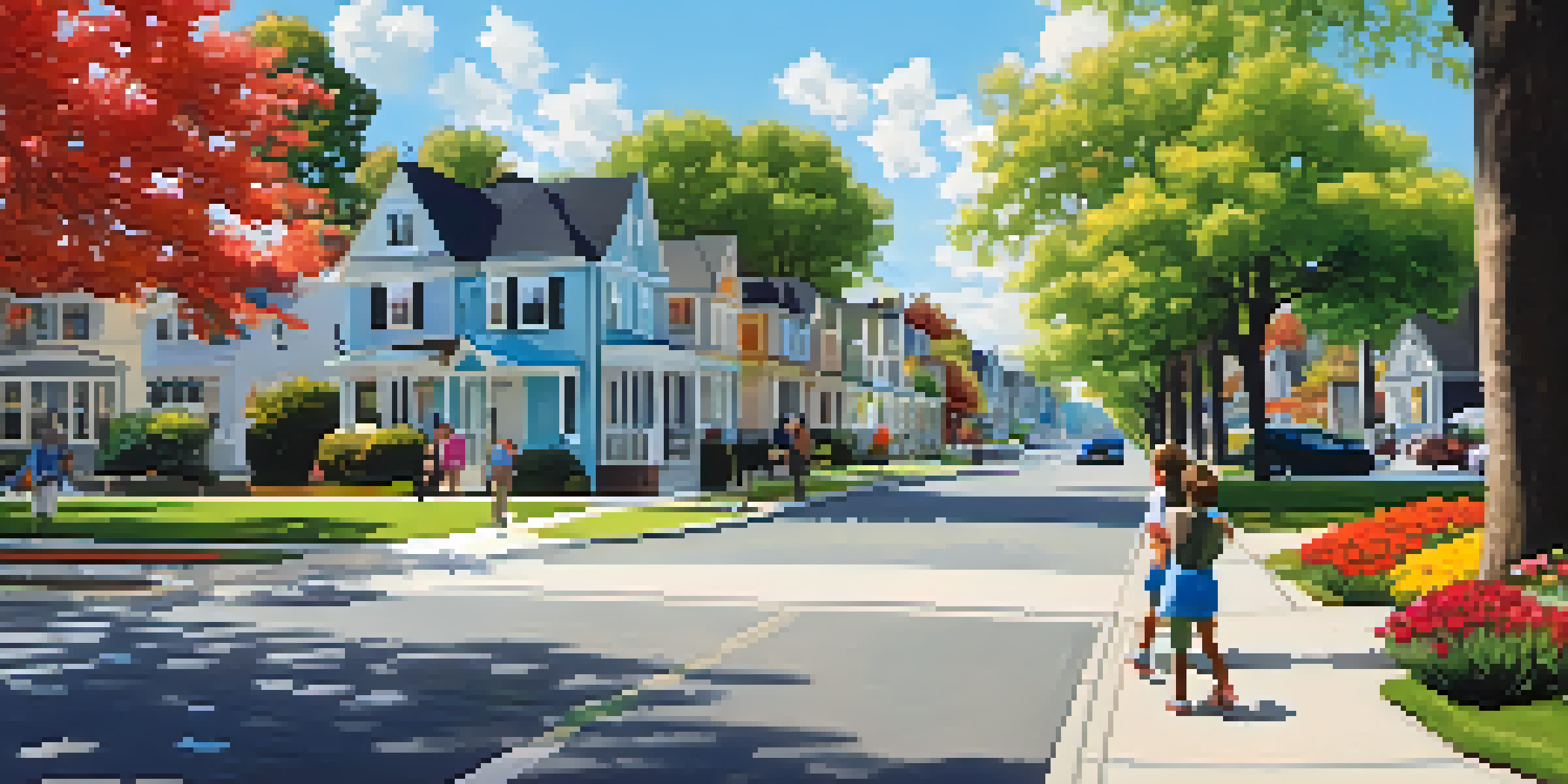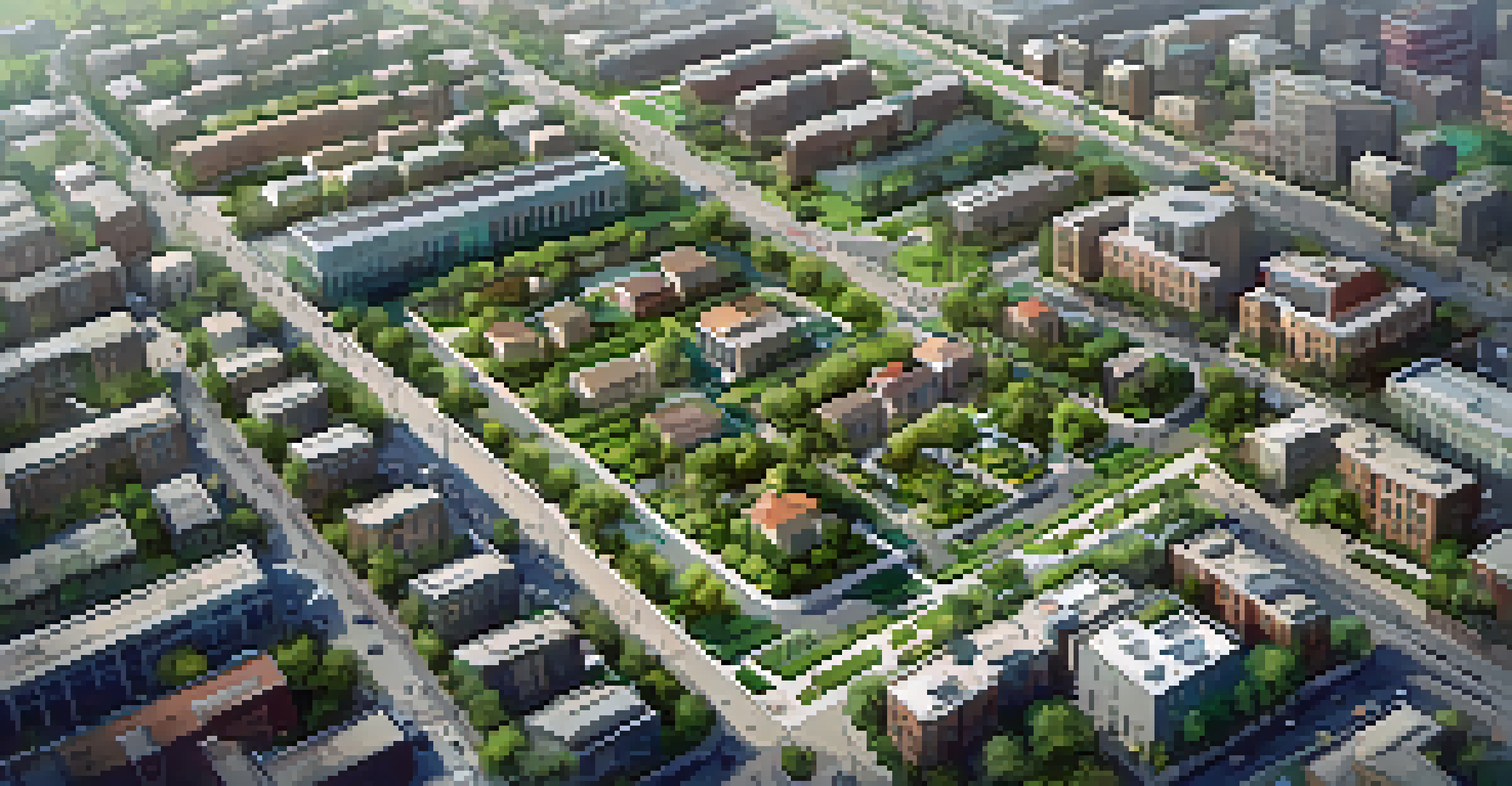Zoning Laws and Their Role in Urban Sprawl

What Are Zoning Laws and Why Do They Matter?
Zoning laws are regulations that dictate how land can be used in specific areas. They determine whether a parcel of land can host residential, commercial, or industrial activities. These laws are crucial because they help maintain order in urban development and ensure that communities are organized in a way that meets the needs of their residents.
Good zoning laws can help ensure that communities are organized in a way that meets the needs of their residents.
Without zoning laws, you could find a factory sitting next door to a school, leading to potential safety and health concerns. This kind of chaos can drive away residents and businesses alike, ultimately harming the community's economic stability. Thus, zoning laws play a vital role in preserving the character and functionality of neighborhoods.
In essence, zoning laws serve as the framework for urban planning, guiding how cities grow and evolve. They can shape everything from the local economy to the environment, making it essential for community members to understand their implications and influence.
The Relationship Between Zoning Laws and Urban Sprawl
Urban sprawl refers to the uncontrolled expansion of urban areas into the surrounding countryside. It can lead to a range of issues, including traffic congestion, loss of green spaces, and increased reliance on cars. Zoning laws are a significant factor in either curbing or exacerbating this phenomenon.

For instance, if zoning laws promote low-density housing in suburban areas, they can encourage more people to move away from urban centers. This can result in longer commutes and a greater demand for infrastructure, contributing to the very sprawl that zoning laws aim to manage. Conversely, mixed-use zoning can help create denser, more walkable communities that mitigate sprawl.
Zoning Laws Shape Urban Development
Zoning laws regulate land use, influencing community organization and urban growth.
Ultimately, the effectiveness of zoning laws in controlling urban sprawl depends on how well they align with sustainable development goals. Well-planned zoning can foster a balanced growth that benefits both urban and suburban areas, reducing the negative impacts associated with unchecked expansion.
Types of Zoning: Residential, Commercial, and Mixed-Use
Zoning can be categorized into different types, with residential, commercial, and mixed-use being the most common. Residential zoning typically designates areas for housing, ensuring that neighborhoods remain safe and family-friendly. It also stipulates the types of homes that can be built, whether single-family homes, townhouses, or multi-family apartments.
Zoning regulations can either hinder or facilitate sustainable development.
Commercial zoning, on the other hand, is aimed at businesses and retail spaces. It dictates where stores, offices, and other commercial entities can operate, which directly impacts economic vitality in an area. By separating commercial from residential zones, cities can reduce noise and traffic in neighborhoods, creating a more pleasant living environment.
Mixed-use zoning blends residential and commercial spaces, promoting a more integrated community. This approach encourages people to live, work, and play in the same area, reducing the need for transportation and fostering a vibrant neighborhood atmosphere. Each zoning type has its role, but the challenge lies in striking a balance that addresses community needs.
The Benefits of Effective Zoning Regulations
Effective zoning regulations can lead to numerous benefits for communities. They can promote sustainable growth, enhance property values, and improve quality of life for residents. By carefully planning land use, cities can ensure that necessary amenities like parks, schools, and shops are conveniently located.
Furthermore, well-implemented zoning laws can help preserve the environment by protecting green spaces and natural resources. For example, zoning can restrict development in ecologically sensitive areas, allowing ecosystems to thrive. This not only supports biodiversity but also provides recreational opportunities for residents.
Zoning Can Mitigate Urban Sprawl
Effective zoning practices can curb urban sprawl by promoting denser, walkable communities.
Additionally, effective zoning can encourage economic development by attracting businesses that fit the community’s character. By creating zones that cater to specific industries, municipalities can stimulate job growth and enhance local economies. In this way, zoning serves as a tool for fostering both social and economic resilience.
Challenges and Criticisms of Zoning Laws
Despite their benefits, zoning laws often face criticism for being too rigid or outdated. Critics argue that these regulations can stifle innovation and prevent communities from adapting to changing needs. For example, if zoning laws do not allow for mixed-use developments, communities may miss out on opportunities for vibrant, self-sustaining neighborhoods.
Moreover, zoning can inadvertently contribute to social inequality. If certain areas are zoned exclusively for high-end developments, it can push lower-income families further away from essential services and job opportunities. This zoning practice can create socio-economic divides, making it difficult for some residents to thrive.
Another challenge is the complexity and inconsistency in zoning laws between different municipalities. This can lead to confusion and frustration for developers and residents alike. As cities evolve, it’s essential that zoning regulations are regularly reviewed and updated to reflect current needs and priorities.
The Future of Zoning Laws in Urban Development
As urban areas continue to grow and change, the future of zoning laws will likely evolve as well. Innovations such as smart city technology and sustainable design practices are prompting cities to rethink traditional zoning approaches. This could lead to more flexible zoning laws that better accommodate the needs of modern communities.
In addition, there is a growing trend toward community engagement in the zoning process. Many cities are now involving residents in discussions about zoning changes, allowing for a more democratic approach to urban planning. This participatory process can help ensure that zoning laws reflect the desires and needs of the community.
Community Engagement in Zoning
Involving residents in zoning discussions fosters a more democratic approach to urban planning.
Ultimately, the future of zoning will hinge on balancing growth with sustainability. As cities face challenges like climate change and population density, adapting zoning laws to prioritize environmentally friendly practices will be crucial. This evolution can help create resilient urban spaces that enhance the quality of life for all residents.
Conclusion: Understanding Zoning's Impact on Our Communities
Zoning laws play a pivotal role in shaping our urban landscapes and community dynamics. By regulating land use, they influence everything from property values to traffic patterns, and even social equity. Understanding these laws is essential for anyone interested in how cities function and grow.
As we navigate the complexities of urban sprawl, it’s vital to recognize the importance of effective zoning regulations. They can either hinder or facilitate sustainable development, making it crucial for policymakers and community members to engage in meaningful discussions about zoning practices.

In conclusion, zoning laws are more than just bureaucratic red tape; they are tools that can foster vibrant, healthy communities when used wisely. By advocating for thoughtful zoning practices, we can help shape the future of our cities in a way that benefits everyone.